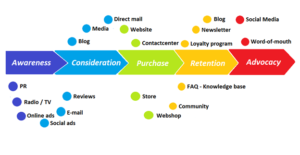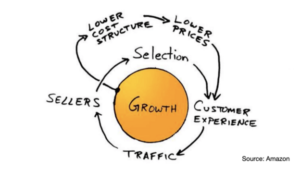From funnels to flywheels
Jul 18, 2022Traditional sales organizations used the concept of a sales “funnel” to describe the process through which potential customers move, ending up with sales at the end. Winners today have abandoned that way of thinking in favor of building flywheels – business models in which every element reinforces every other.
Ah, the marketing funnel, we knew it well
A staple of the required business school marketing course, students are taught that prospective customers move through a predictable set of experiences. It is usually depicted as something like this:

Understanding the funnel makes sense when one is trying to evaluate the leading indicators of future sales success. Gail Goodwin, the onetime CEO of small business direct mail service Constant Contact observed that looking after the pipeline – the flow through the funnel – was essential to the company escaping the “long, slow SaaS, ramp of death.”
The funnel concept has a lot to like. For starters, you could begin to anticipate how well your business would do by measuring how many potential customers got in at the beginning (awareness) and then apply metrics to what proportion of them would take the next step. If you knew 1,000 people were aware of your offering and that 10% of them would do something that expressed interest, you would know that you were likely to have 100 of them at that stage. If 50% of these folks started to make buyer-like noises, you could tell how many would be doing that, and so on. It made for a nice way to model leading indicators of buying behavior.
For B2C businesses, creating awareness was often a huge barrier to entry – television, magazine and radio advertising are expensive. For B2B businesses, armies of sales reps were used traditionally to create awareness, also expensive and a barrier to entry.
Cracks in the funnel model
But the funnel has its limitations, and the inflection point that is digital has exposed them. As Hubspot co-founder Brian Halligan points out in a recent Harvard Business Review article, it was born at a time when there were tremendous information inequalities between buyers and sellers. Those selling a product could leverage this information imbalance to create a role as a trusted partner because the buyer couldn’t solve their own problems.
With the widespread advent of instantly accessible information as the world went digital, both getting information and making comparisons between various offerings became radically faster, easier and cheaper. Buyers were no longer dependent on a seller to move through a funnel. Interactions rather than transactions became the norm, and the relationship didn’t end with a sale.
Rather, the relationship between buyers and sellers began to resemble a continuous flow of interactions. In many modern models, the sale isn’t even the end of the process – it’s somewhere in the middle (particularly true with subscription and software-as-a-service models). Here’s an example:

Source: https://commons.wikimedia.org/wiki/File:Customer_journey_with_touchpoints_English.png
What you’re creating here is not a funnel so much as a winding journey with lots of touch points (and lots of opportunities for customers to get lost).
From winding journey to flywheel
A step beyond this revised view of an interactive customer journey is when a company can create what Jim Collins famously called a flywheel. As he puts it, imagine rolling a huge, heavy disc on its axel. The first few times you try to roll it, you have to put a huge amount of energy in for a seemingly insignificant response. But as it picks up momentum, the same amount of effort on your part yields faster turns. The more you go at it, eventually the flywheel takes on momentum of its own and begins to turn without any particular effort from you.
What modern digital organizations have done is to in effect, create business models that are flywheels, in which additional force on any part of the model creates multiplicative effects throughout the business. As Collins describes, the flywheel, once in place, becomes a force multiplier.
Perhaps the most famous example of the flywheel in action is the case of Amazon. At a corporate retreat in 2001, Collins was explaining the concept at an Amazon retreat and it proved an “AHA” moment for their CEO, Jeff Bezos. As Brad Stone describes in his book The Everything Store the relationship between the levers Amazon could push became instantly clear to him.
The resulting relationship (supposedly drawn on a napkin) looked like this:

Source: https://medium.com/swlh/how-to-increase-your-followers-using-amazon-flywheel-strategy-9033104fffb8
Low prices and a large selection of products drew in customers just as the company’s focus on creating great customer experiences kept them coming back, increasing traffic. This in turn attracted 3rd party sellers, who increased selection. Underpinning it all is a low-cost structure that supports the low-price commitment. When you look at it, it’s genius! Even better, it compounds so that every turn of the wheel creates acceleration.
Where from here?
So much for the sales funnel, bring on the flywheel! Think about expressing your business in these terms.

